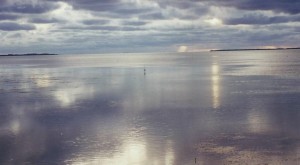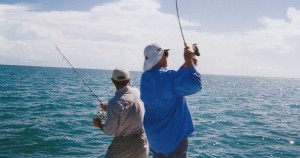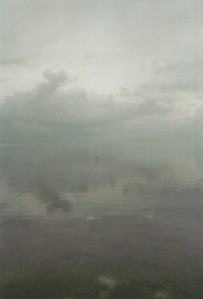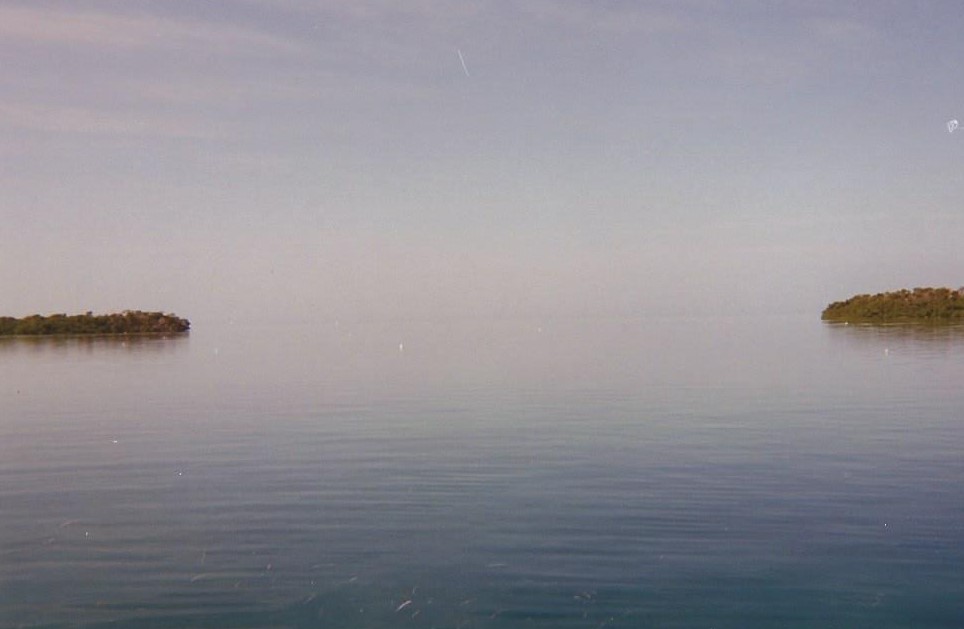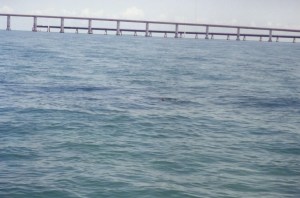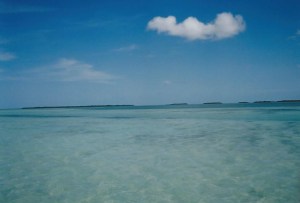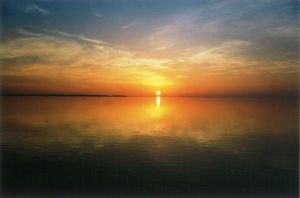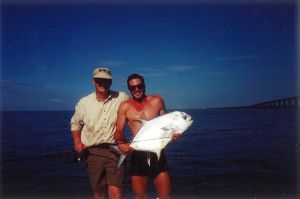Ralph Walls was my best friend. I was introduced to Ralph by a mountain of a man, Mac McDermitt. Mac, who was the kind of guy that simply took over a room as he entered, owned Capital City Excavating Company an underground contractor in Columbus. Ralphie, as we called him, was Capital City’s treasurer and accountant. As Ralphie would self describe, he was a bean counter. Ralph was an outstanding collegiate golfer who played at Ohio State and maintained a four handicap well into his fifth decade. Ralph took me under his wing and tried to teach me to play golf. I was not a very good student.

Ralph as Golfer 1992
Another mutual friend, Lee Mitchell, provided Ralph and I with the opportunity of becoming fishing buddies as well as golfing friends. Lee owned a gorgeous 32 foot Bertram boat which he captained on Lake Erie. Ralph and I spent many crazy days on Lake Erie catching perch and walleye. When absolutely necessary, we quenched our raging thirst by drinking 7 oz Little Kings. As the summer sun heated up, Ralphie would often be heard to say “I need something for my lips.” Translation – is there a cold Little Kings or Heineken around?
Ralph had many other verbal masterpieces which are carried forward in my own personal vernacular. If I hit an errant golf shot and the ball was resting in difficult spot, Ralph would say “Rowe, you hit it here, now hit it out.” Translation – quit whining and put the ball back in play.
Ralph became a client. Ralphie would say, “Rowe, I will pay you for your legal advice and listen to your business advice.” Translation, I know you have opinions on how I ought to run the business but you are probably wrong.
When I presented Ralph with a legal document for review, he would sadly shake his head and say “Rowe, you lawyers write all these words, but you never put pencil to paper to see if the numbers work.” Translation, you do not have a practical bone in your body or brain cell in your head!
In late-night gin rummy games, Ralphie was often heard to say, “Rowe, it’s a quick game.” Translation, please make up your mind and make a play!
Ralph and I would often share business and personal concerns. Even though we were guys, we could share not only what we were thinking but also how we were feeling about the challenges of the moment. When discussing a particularly thorny issue, Ralph would shake his head with amusement and say “Rowe, I do not understand everything I know about that.” I ask you to translate that profound observation.
When the incredulous occurred, Ralph would laugh and say ” Been to two goat ropins’ and three county fairs but I ain’t never seen nothing like that before!” Translation – sometimes there is just no explaining the events of real-life.
Each year, Ralph and I looked forward with great anticipation to a fishing trip to the Florida Keys. We dubbed that trip the FIFO Flats challenge. Over the years, many different fishing friends participated in the trip. However, Lee Mitchell, Ralphie, and I were the mainstays. Ralph and Lee fished for one or two years before I was invited to join the group. Starting in 1988, Ralph, Lee, and I would head to Marathon, Florida in the Florida Keys for a November week of pursuing bonefish, permit, and tarpon on the flats.
On November 26, 1989, Ralph, Lee, and I headed to the Keys with friends, Frank Catchpole, Bill Keethler, and Ron Souder.
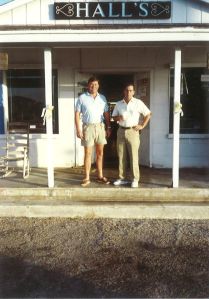
Ralph and Frank Catchpole waiting on the fishing day in front of Halls’ Bait Store, Marathon, Florida
During our road trip certain rituals were honored. We would stop at World Wide Sportsman in Islamorada, Florida and speak with the owner, George Hummell, who had the distinction of being the personal bonefish guide of President George H. W. Bush. Another mandatory stop was the Green Turtle Inn where we dined on the Sunday evening before the fishing began.
As we dined at the Green Turtle, I noticed that as the adult libations were poured and stories of the prior year’s fishing were being shared, inaccuracies popped up. Knowing the nature of fisherman, I did not find the perceived exaggeration the least bit curious. However, I decided to do something about it. Upon arriving in Marathon at about 8:30 in the evening, I asked Lee if I could borrow his truck “Where you going?” “Kmart,” I replied. “What for?” “Not telling you,” I replied. “Can I use the truck or not?” Mitchell tossed me the keys and off I went.
I returned with a blank blue journal. For those of us who participated in this spirited fishing tournament known as the FIFO Flats challenge, the Journal became as cherished as the Bible to the religiously inclined. For over 20 years, every fish we caught was recorded. Every story was recited with only slight embellishment. Every adventure and misadventure was noted. As the years rolled by, I never went to dinner after a fishing day without the journal so that the stories we told could be checked against the facts as I had written them.
In thinking and writing about Ralph, the journal prompted many smiles. I hate the fact that Ralph is no longer here to smile with me. In 1993, Ralph discovered he had cancer. Even though he had been a lifelong smoker, the moment the diagnosis was delivered to him, he quit smoking.

Ralph and his True cigarette at the Siesta Motel
A couple of years later, I was visiting Ralph at his home during the final stage of his illness. As we talked, the phone rang. The caller was his doctor. After hanging up the phone, Ralph simply stated, “Doc said there’s no more treatment available for me”. He walked to a drawer in the kitchen, pulled out a pack of his old reliable True cigarettes and lit up. While there was hope of recovery, he was willing and able to do something for himself and his family. Quit smoking. I am certain that all of us have a bad habit we should surrender. If you do, stop now and let Ralph be your inspiration.
When the summer of 1994 rolled around, I sent our annual fishing letter to the prior year’s participants in the FIFO Flats challenge. Basically, the letter asked “are you going fishing or not? If you are going, send me a deposit of $300 which you will lose if you don’t go!”
As I dropped the letter in the mail, I wondered whether Ralph would send me a check. He did. In the spring after the trip, towards the end of his life, we were talking and I asked Ralph if he had fun on the trip. He said, “No, but I am glad that I went.” Ralphie had a knack for saying things which delivered meaning far beyond the specific words he used.
By reason of Ralph’s illness, the 1994 trip was different. Ralph’s wife, Sherry, came along as nurse and roommate.
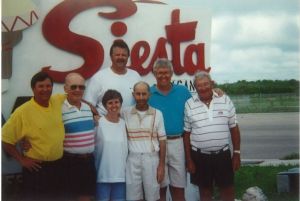
Sherry Walls and the Gang
Sherry helped Ralph prepare as he faced the daily challenge of going to breakfast at Stout’s, climbing into a pickup truck with his guide and heading up or down Highway 1 to a fishing destination. Without Sherry, Ralph could not have fished.
Our guides also went above and beyond the call of ordinary duty. By the time of the 1994 trip, our fishing guides and Ralph were friends. The angler/guide friendship is unique. The relationship is based on a mutual love of a common endeavor. The friendship is nurtured by the respect a guide gives an angler such as Ralph who tried very, very hard no matter what the fishing conditions. The angler reciprocates by genuinely appreciating the skills of a guide who is willing to help an angler try to catch a fish which the guide knows he would without doubt land if only the guide could change places with the angler.
I want to share the events of Ralph’s last fishing week as reflected on the pages of the blue journal.
The first day of the Ralph’s last trip was November 8, 1994. Because of his illness, Capt. Harry Spear decided to fish Ralphie near Marathon where our home away from home, the Siesta Motel, was located. After a couple hours fishing, Harry ran Ralph into the Siesta for a nap.
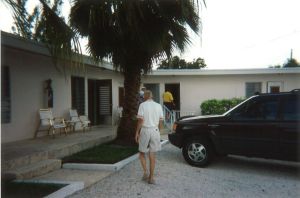
Ralph Needs Some Rest
After the rest, Ralph went back out fishing and caught an 11 pound bonefish which is no easy feat. The first run of an 11 pound bone is going to strip somewhere between 100 to 150 yards of line against the drag. Typically, the guide is screaming for his angler to stand with arms and fishing rod extended as far as possible overhead to create a sharp angle between where the line enters the water and the underside of the fish’s mouth. The angle is important to prevent the fishing line from becoming imbedded in the lush turtle grass growing on the Oceanside flats near Marathon. If the angler does not keep the line off the bottom, the streaking fish will eventually brush the line against a small coral head or sea fan and break off. On this day, Harry was determined to do everything in his power to help Ralph catch the hooked fish even though Ralph could not stand up, let alone extend the rod over his head. Harry fired up the outboard motor and followed this big bad bonefish with the skiff. Ralph fought the fish while seated on the small casting platform strapped to the front of the boat. After a determined dogfight, the fish was captured and released – a good start to a physically challenging week for Ralph.
On November 9, 1994, Ralph and Rich Mealy fished with guide, Steve Huff. They could not find any bonefish but ran into a herd of permit. Ralph caught a 25 and an 18 pound permit. My journal notes indicate that they “chased Ralph’s permit for an hour.” A 25 pound permit typically takes 15 to 25 minutes to land. For a 25 pound permit to stay hooked for the better part of an hour without dragging the line against some obstruction to free itself was a miracle! Also, visualize the effort it took for Steve Huff to pole the 16 foot skiff loaded with two anglers for an hour chasing an angry 25 pound permit!

Steve Huff Unhooks Ralph’s Permit
On November 10, 1994, Ralph was feeling tired. He and I fished together with guide, Ray Fetcher. We quit at one o’clock and returned to the hotel. I later fished by myself wading High School Flat. As I entered the water, a huge bonefish was moving slowly along about 8 feet from shore. Needless to say, I did not catch it, but at least Ralph was getting his rest.
On November 11, 1994, the last day of the trip, Ralph and I fished with Harry Spear who launched the skiff near Islamorada. Late in the morning, Harry was running the boat towards a favorite Florida Keys fishing hole, Long Key Bight, which over the years affectionately came to be known as “The Bight”. All of us had sufficient fishing success in the Bight so as to cause us to genuflect each time we approached its entrance. As our boat was flew around the corner of a small mangrove island on the backcountry side of Islamorada, a pelican spooked from its perch in the mangroves and flew directly into the boat. The agitated bird struck Ralphie in the shoulder and knocked him to the bottom of the skiff. The pelican flopped around the boat. Ralph flopped around the boat. As he picked himself up, mildly irritated, Ralphie softly said “What the F…!”
Neither one of us fished well on that last day. We knew the unstated reality that this trip was our last together. We did not see fish well even though there were plenty of fish to see. We did not cast accurately to the fish we did see. According to the journal, we managed to catch one small bonefish the entire day. However, the fishing mattered very little.
All of us privileged to exist in this world long enough to have encountered some living and dying have reflected upon matters of the spirit. We have pondered the question of what awaits us after we pass from this earth. As for me, my friendship with Ralph is kept alive even though he is not physically present. The memories of our shared adventures keep Ralph at my side. Perhaps this could be eternal life.
Long Key Bight was the last fishing water Ralph and I shared. Harry poled every bit of the huge expanse of the Bight but we saw no fish. As the beautiful golden November afternoon slid away, the angle of the sun sharpened. The brisk ever present wind began to lay down. Rippled water turned to glass. As Harry gently poled out of the Bight, he pushed the skiff approximately 50 yards from shore. The shallow water was punctuated by solitary mangrove shoots fighting to establish themselves in their salty home.
Suddenly in the final moments of the afternoon, a huge permit gently finned out among the sparse patch of mangroves directly in front of the skiff. Ralph and I saw the motionless fish and glanced at each other in wonder. The skiff drifted slowly towards the permit. The fish was not startled. The fish was not scared. The fish did not streak off in panic. We were awestruck. Even though we had our rods in hand with silver dollar sized blue crabs attached to hooks, neither of us cast. Harry said nothing. Harry had never before been mute when a fishing situation called for his angler to cast. The permit slowly began to swim directly in front of the bow of the boat no more than 10 feet from where we stood paralyzed. As we silently watched, the giant fish gently eased away from Long Key Bight on the watery path leading to a sun setting in the Gulf of Mexico.
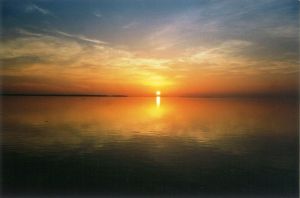
Sunset Over Still Water
As the silvery permit faded from sight, I whispered to Harry “If we had cast, what chance did we have to catch that fish?” Harry replied, “None”.
In over 20 years of fishing the Florida Keys, I have never seen a permit behave in similar fashion. This fish had no fear of what came next. Nor did it have any great concern for its current circumstance. Since that bittersweet last fishing day, the gorgeous old permit has for me represented Ralph’s spirit as he too slowly slipped away from his family and friends towards a different destination.


